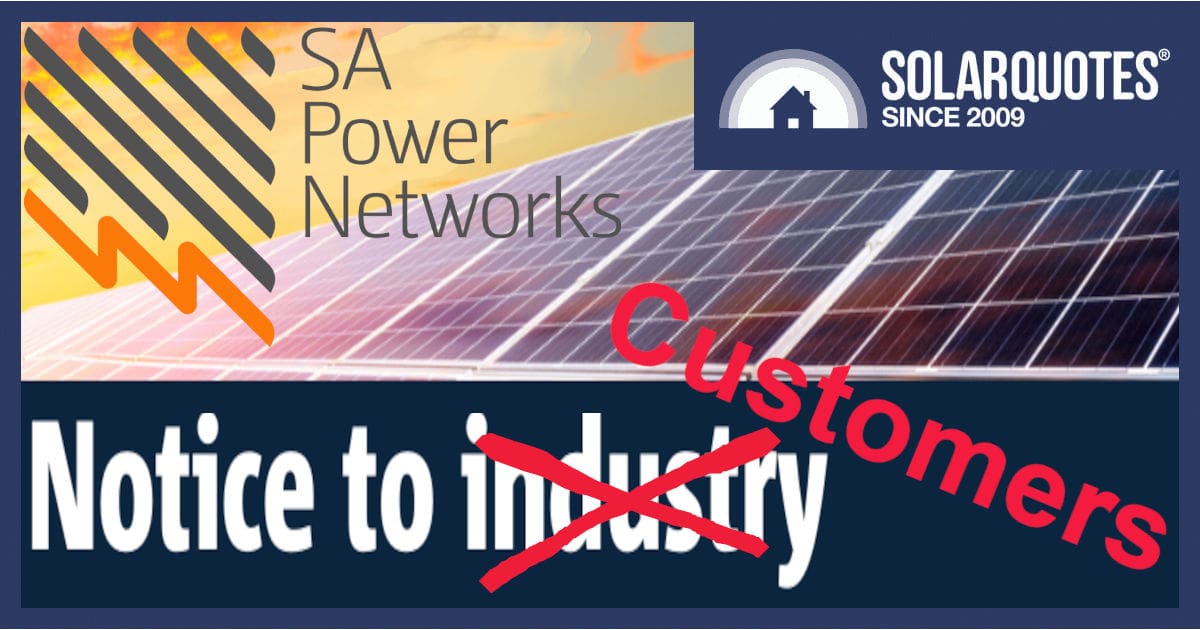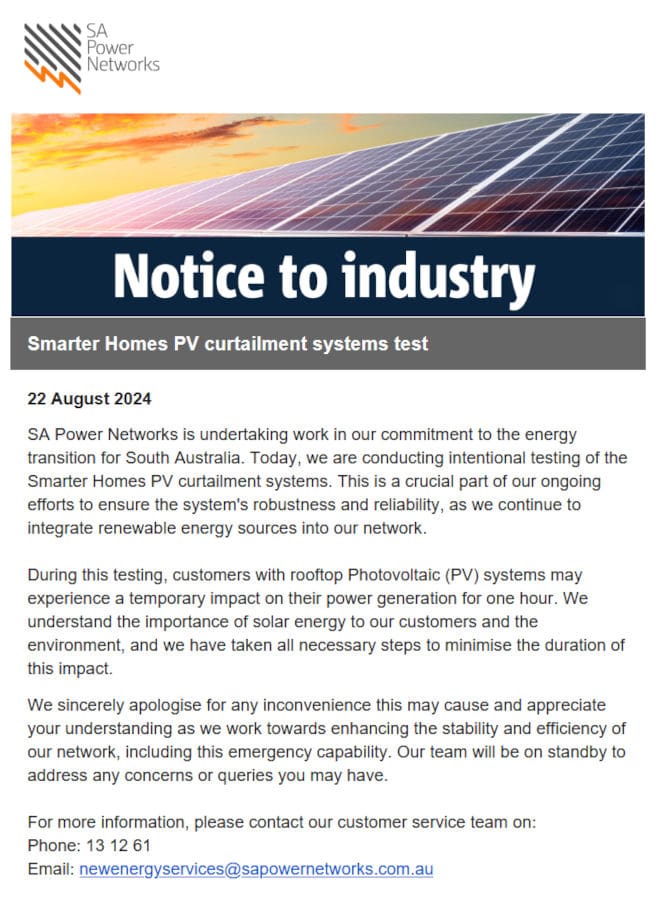
An Industry update from SA Power Networks – That Should Go To Customers
AUGUST 22nd 2024
Be alert, but not alarmed. Solar customers in South Australia should be aware that SAPN is conducting some experiments today which might see your solar power being temporarily turned down or turned off.
If your solar inverter was installed under the so-called Smarter Homes programme, it may be connected to a dedicated circuit from your retail electricity meter or have an internet connection that allows SAPN to curtail solar production during grid emergencies.
During times of exceptional solar generation, combined with low overall demand (or possibly a network calamity) there’s simply too much electricity on the network. To keep everything under control some of this solar needs to be turned off.
Testing Times
As an electrician, I receive emails from my local Distribution Network Service Provider under the heading “Notice to Industry,” and most of them are pretty mundane.
This morning’s missive was more interesting, and it makes me wonder why it’s not more widely circulated.
Forget about planning. The message was that TODAY, they would be testing the “Smarter Homes” solar curtailment capability and that solar inverters may be down for no more than an hour.
As we head for Spring, when the clouds clear and fewer people are using energy hungry heating appliances, there’s a good chance that a sunny Sunday will produce the perfect conditions for 110% of state demand to be coming from our rooftops.
When the entire grid is effectively running in reverse, the authorities in charge get a little nervous about steering it. For 2% of the year they like to exert some extra control.
There’s Two Kinds Of Control
Introduced in 2020, the “Smarter Homes” program is proof that red tape is easily cut if somebody in authority gets scared enough.
It was a stopgap if we’re being honest, but a necessary backstop, followed by Queensland some years later.
Solar power installed under this programme is controlled in two ways. Some systems have your inverter connected to a dedicated contact in the retail meter. This is hilarious when the retailer cocks up the programming and pretends your inverter is a hot water service. Solar doesn’t work when switched on at 11:00 PM.
When they’re working correctly, these systems have a standard 5kW export limit. Once SAPN puts out the “bat signal” to curtail generation, your inverter switches off, and you revert to being a standard electricity consumer.
The more refined version of this control system still has a fixed 5kW export limit but uses an internet connection to throttle your inverter down. When SAPN send out the signal, it won’t export anything to the grid, but it still generates for you to use at home.
To the best of my knowledge, these are the systems being tested today.
Flexible Connections Are Better
Modern solar systems are designed to work in a similar fashion. Although it’s not available in all areas just yet, dynamic controls mean SAPN can turn your solar down when needed, but most of the time, it will be turned up so it can export its full capacity. These systems don’t have a standard 5kW export limit, but if there’s no internet available, a hard limit of 1.5kW is applied.
Don’t Ring Your Solar Installer Today
Hopefully, your system has some monitoring that’s already alerted you to an unexpected drop in solar output.1 In the past, these events have caused installer phones to ring hot as people complain about what they perceive to be faults in solar power systems.
To be honest, I don’t know why SAPN seem to keep these things a secret; it’s a question I’m going to ask them.
The only surefire indication of a curtailment event in progress is having a Catch Control (formerly Catch Power Relay) installed as your consumption meter. Catch’s Monacle monitoring platform offers a real-time animation to show when solar is being throttled.
Switch It Off and On Again
If your solar doesn’t appear to be working tomorrow, it may need some attention. Next to your inverter, there should be a detailed label explaining the shutdown procedure.
The AC isolation is either a dedicated switch next to the inverter or a circuit breaker in the nearby switchboard. DC isolation is either a dedicated switch or breaker adjacent to the inverter or a knob on the side or bottom of the inverter itself. (If you have microinverters like Enphase, then there’s no DC to worry about)
Basically, turn the AC supply off first and then the DC supply off. Wait half a minute, switch them back on, and everything should be apples. If it’s not, ring your installer or contact Solar Quotes, and we’ll find you one.
Footnotes
- If you don’t have solar monitoring set up, there’s a range of very good reasons to get it sorted ↩


 RSS - Posts
RSS - Posts



Our power went out for ~5 seconds just before 12 noon today down here at Moana
I’ll check inverter and that Solar is running ..
Think I’ve asked before, but if you have a battery and therefore microgrid, does that continue to function in shutdowns like this?
Hi Nick,
SAPN aren’t turning the power off altogether, they’re just testing the control mechanism which allows them to shut down or curtail solar. Hybrid systems with a battery will not be connected using the dedicated meter circuit, so they’ll continue to work, but not export.
Thanks Anthony. Bizarre that at a time when a country has record electricty prices, it’s needing to throttle generation of near-free energy. We all know the history, but we can still marvel at the stupidity of it all.
This was NOT the case for me. My system was COMPLETELY shut down.
My batteries had 81% capacity. BUT, the inverter was put into ‘Standby’ Mode.
This meant all power draw was from the grid. The batteries were disabled.
Not happy !
Yes, it’d be nice to be advised of this, even if it was just to limit the panic calls to solar companies to find out what’s happening.
1030 – 1145 today zero to grid, so looks like back to normal now.
Now I have to work out if my 10kw export limit has been mucked about with.
My 11.23kw system seems to be getting limited to 2kw production when using the normal 0.4 – 0.45 kw into the home, but if I am using say 5kw of power running a couple of high usage appliances, the production also jumps to match that usage.
I guess it’s all about respect, or in this case the lack of.
Very poor form in my opinion.
The lack of respect for the Customer, is widening it’s reach.
My inverter went down today here on Kangaroo Island right at about 10.30am, as I was charging my EV. It was so weird seeing 0kw in bright sun so I immediately called my installer, Yorke Solar, who remotely did a firmware update on my Fronius Gen24.
It came back just fine and the technicians thought it might have crashed because of a firmware issue, but this explains it all.
Good to know and a little inconsiderate of SAPN if you ask me!
Just a left field thought, but why don’t they pull their collective fingers out and start daytime on-demand heating of electric storage hot water services and/or charging of home batteries with the excess electricity, rather than turning the wick down on solar and wasting the opportunity to generate power and store it.
David, wouldn’t THAT make a whole lot of sense !
That might yet be a little beyond the scope of various systems still, but a great way to truly take advantage of all the progressive rooftop solar.
But skeptical me suspects profits for retail power cos is far more important than such objectives of actually saving the planet (from any perceived risk).
Because that doesn’t generate them income.
I know basically nothing about batteries and solar. However I have seen the grid taking power from our batteries when they are at 60% or less. We then have no battery power that night to run our house and have to buy from the grid. Is this right?
Not unless you are on some sort of VPP plan (or there’s some major sort of installation error).
Did you get your system / battery on a deal with VPP included ?
Usually you nominate what % of battery you allow the power co to take though, so you should be aware if this is in place.
Having read many comments and given this a little thought, here’s a wayout idea. You’ll need to excuse my occasional sarcasm and cynicism in this comment.
I understand that everyone pumping into the grid when it doesn’t need it is a problem. Perhaps something that should have been thought of before the huge drive to install solar and yet they continue to promote it with vigor.
So, I would imagine that smart meters can be individually controlled in a similar fasion to computers on a network. If not then I ask why.
Assuming they can be controlled individually, why doesn’t the Government devise a scheme where excess power during these times is diverted to Pensioners and organisations like St Vinnies, Red Cross and Salvation Army etc for Free?
You read many horrible stories about Pensioners having to make awkward decisions about whether they can afford to eat, medicate or keep warm or cool. In this day an age, it’s a disgusting way to have to live!
With a bit of forward planning, (as different to the typical Governments retrospective planning) people who are not so well off, could have a Heat Pump HWS and Reverse Cycle aircontioner provided and run it for free during times of excess power.
I would happily forego my FIT during these times if the masses received some practical benefit.
It could be funded in part from the amount spent on foreign aid. We could call it Australia Aid and start looking after our people first.
Curtailing power generation is a knee jerk reation brought about my very poor planning. The email from SAPN is proof of this, otherwise the “Testing” would have commenced not long after the uptake of solar (5 years ago).
Anyway, food for thought. We just need some Pollies with vision and courage, like finding Hens Teeth unfortunately.
That’s also a great idea Paul, and yes, with fits now in SA down to 3c in general, it’s nothing in the scheme of things and where the real solar savings are (self consumption).
So using that excess power to help others is a great concept, be they family, neighbours, or worthy charities, and not a huge impact on somebody’s solar benefit.
Isn’t there now a way you can do this ?
Yes, just did a google search, AGL Solar Exchange (do they take a small cut ? Expect so).
Also google solarrun solar energy trading.
Or maybe just give pensioners free electricity from 10AM to 3 PM. That will encourage them to use more then and less outside those hours. It wouldn’t even need any changes except to the pensioners electricity rates, ie off peak = free for qualified pensioners.
David that’s so simple I think it’s genius.
Give power, literally and metaphorically to the people who are time rich/cash poor and they’ll make excellent managers to reduce the duck curve.
Combined with heat pump hot water this will be a winner in my opinion.
Again, my simple answer is because it does not generate the power networks and retailers income, so that solution is not considered.
i too was using grid power for an hour